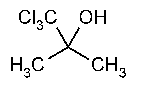Chlorobutanol
2-Propanol,1,1,1-trichloro-2-methyl-.
1,1,1-Trichloro-2-methyl-2-propanol [57-15-8].
Hemihydrate 186.46 [6001-64-5].
»Chlorobutanol is anhydrous or contains not more than one-half molecule of water of hydration.It contains not less than 98.0percent and not more than 100.5percent of C4H7Cl3O,calculated on the anhydrous basis.
Packaging and storage—
Preserve in tight containers.
Labeling—
Label it to indicate whether it is anhydrous or hydrous.
Identification
B:
To 5mLof a freshly prepared solution (1in 200)add 1mLof 1Nsodium hydroxide,then slowly add 3mLof iodine TS:a yellow precipitate of iodoform,recognizable by its odor,appears.
Reaction—
Shake thoroughly 0.5g with 25mLof water:the water remains neutral to litmus.
Water,Method Iá921ñ:
not more than 1.0%(anhydrous form)and not more than 6.0%(hydrous form).
Chloride—
To a solution of 0.50g in a mixture of 25mLof diluted alcohol and 1mLof nitric acid,add 2mLof silver nitrate TS:any turbidity produced is not greater than that produced from a control solution containing 0.50mLof 0.020Nhydrochloric acid in place of the Chlorobutanol (0.07%).
Organic volatile impurities,Method IVá467ñ:
meets the requirements,using mass spectrometric detection.
Assay—
Denatured alcohol—
Dilute 100mLof isopropyl alcohol to 1000mLwith alcohol.
Potassium hydroxide solution—
Transfer 58g of potassium hydroxide to a 1000-mLvolumetric flask.Add 100mLof water to dissolve,then cool the solution.Dilute with Denatured alcoholto volume,and mix.Prepare fresh just prior to use.
Procedure—
Transfer about 100mg of Chlorobutanol,accurately weighed,to a glass-stoppered,flat-bottomed boiling flask.Add 50mLof Potassium hydroxide solution,attach the flask to a reflux condenser,and reflux for 1hour.Allow the flask to cool while still attached to the condenser,then add 100mLof water,using a portion of the water to rinse the condenser and its tip.Add 15mLof nitric acid while stirring.Titrate with 0.1Nsilver nitrate VS,determining the endpoint potentiometrically,using a silver-billet combination electrode,consisting of a metallic silver indicator electrode and a double junction reference electrode that allows use of a nonchloride filling solution (such as ammonium nitrate solution)for determining chloride,or equivalent (see Titrimetry á541ñ).Perform a blank determination,and make any necessary correction.Each mLof 0.1Nsilver nitrate is equivalent to 5.915mg of C4H7Cl3O.
Auxiliary Information—
Staff Liaison:Daniel K.Bempong,Ph.D.,Scientist
Expert Committee:(EMC)Excipients:Monograph Content
USP28–NF23Page 2988
Phone Number:1-301-816-8143
